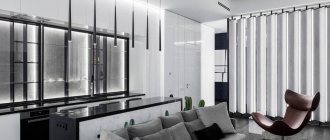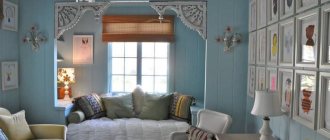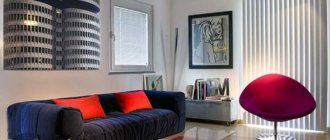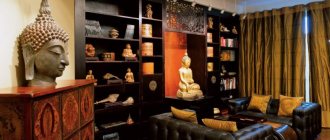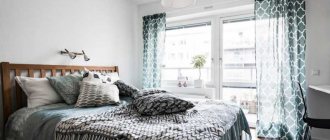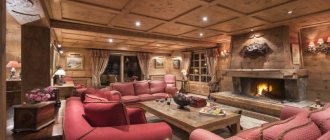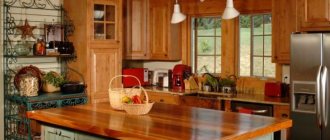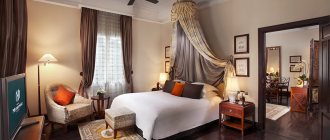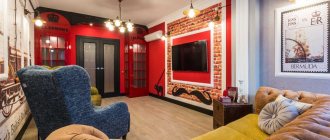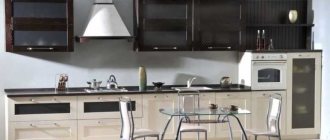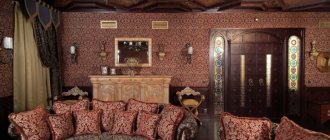Description and features of retro style in the interior
The main features of a retro interior are bright colors, rich motifs and a sense of taste. All of them should be in maximum harmony with each other. But, when organizing such a direction, it is worth adhering to a sense of proportion. Tacky decor and too much furniture will only spoil the design solution.
The declared interior will certainly surprise its owner with its diversity. It will be very different from the usual directions and will fit deeper into living rooms.
Retro style has several features that distinguish it from others:
- use of a furniture set of a contrasting rich shade;
- they try to give antique items a slightly modern look;
- mandatory support for a single color scheme;
- the presence of additional accessories that represent the past.
When choosing an interior solution in a retro style, it is also necessary to take into account the time period that the interior must correspond to. The design may differ individually depending on the years.
Retro style home design with soft, restrained shades Source robdom.ru
Retro style in the interior of a bright room with wooden furniture Source inmyroom.ru
Bedroom in a retro interior with installed massive wooden furniture Source roomester.ru
Photos of the interior in retro style
The post-war style of the last century is ideal for creative people. This can be seen in the example of the project of Diego Revollo Arquitetura, which implemented a design project within a 90 square meter apartment located in Sao Paulo, Brazil.
The white ceiling and walls visually expand the boundaries of a small apartment and fill it with light. The texture of the flooring echoes the exterior finish of the kitchen island and door areas, giving the interior a non-aggressive, even rhythm. The light, delicate tone of the wood, coupled with whiteness, makes up the general background, on which dark accent points are clearly placed.
The kitchen area is marked by a part of the wall and a work island built into it. It is made using dark and light shades of gray and resembles a stone seashore. The pleasant dark blue color of the glossy facades exudes freshness. The large wall image of marble texture is reflected in the glossy surface of the retro-style gas stove, echoing the stone hexagons. The theme of simple 60s geometry is continued with patterns on the soft vinyl covering of the floor and part of the wall.
Figures of rockets ready for launch help create the atmosphere of a time of general interest in space exploration. A burgundy-colored jug and green plants enliven the interior with splashes of color.
The dining area is adjacent to the kitchen, sparing free space. A functional table with stable metal but not massive legs and a smooth, even surface invites you back to the 60s. The Eames DCW (Dining Chair Wood) chairs from designers Charles and Ray Eames are made from molded plywood. They are very comfortable, despite their apparent simplicity. The original idea of additional lighting for the dining area is embodied with the help of a black metal lamp of a simple shape on an unusually long holder. The accessories placed on the podium along the table, as well as the image in a glass frame, leave open questions and room for imagination. Unexpected colors and shapes captivate attention.
Thanks to the ergonomic layout, there was room in the small apartment for a seating area located by the window. It is represented by a comfortable chair in a delicate sea green color, a table with a base in the shape of a bear, and a second multifunctional folding table with a metal body and a surface made of wooden slats. An ashtray with thick glass walls, a book and a photo album speak of the usual ways for the owner of the apartment to spend his free time.
A work office is built into a unique wall module. The cool color of the deep sea breaks into fiery red. The design of the chair presented here was developed back in 1940 by Charles Eames and Eero Saarinen. It also has its own name - “Conversation Chair”, that is, “chair for communication”. Openness and convenience have helped it gain popularity around the world. A table lamp with an unusual design attracts attention.
Opposite the office there is a cozy living room. A sofa with clear rectangular shapes, a coffee table with a glass top, a velvet armchair with high thin legs, a fur throw, flooring with a rough texture - the elements from which the interior is built in a retro style. The temperamental play of textures is smoothed out by a neutral gray color with soft inclusions of shades of blue-green.
A wide bed with bedside tables on both sides is the entire set of furniture that represents the bedroom. A bedspread with a floral pattern, a living flower and wood texture create an atmosphere of comfort and peace of mind here.
Differences in retro style by decade
Every decade has had its own nuances in the design of the retro interior of a house:
- Retro style from the 50s. In this direction there is a perkiness. The interior should not look boring and dull. The use of chrome parts and bright colors is encouraged. All surfaces are finished in a solid shade without any patterns. Furniture items are predominantly of strict shapes with fairly elastic seats.
- Retro style from the 60s. The appearance of the furniture remains the same, but in some places floral motifs and simple, light ornaments appear. The main feature of this interior is the colorful shades. It is also encouraged to combine the unexpected with the ordinary: for example, eye-catching accessories with a primitive set.
- Retro style from the 70s. At this time, contrasting tones fade into the background. They are replaced by warmer and more delicate shades of the palette. The decoration of the walls of this type of interior now includes various ornaments, paintings and drawings. Upholstered furniture and squat coffee tables are a must. Now there are no restrictions at all regarding the choice of furniture shape.
General principles
Retro can be called a protest of dullness and despondency. It is not for nothing that the hippie movement flourished during these years. In the interiors, protest is expressed by bright colors with crazy combinations of shades, furniture with original streamlined shapes, shine and gloss, the use of innovative materials for that time (plastic, chrome plating) and unique accessories.
When retro is now adapted to modern interiors, it looks more restrained. The canvas can be calm and stable, the main pieces of furniture compact, functional and without unnecessary decorations, but the details will not allow boredom: bright textiles, posters, fancy appliances and graphic patterns.
Living room in retro style
The living room in a retro direction is decorated with a limited amount of furniture. Capes and bedspreads with checkered motifs and regular geometric patterns are sure to be spread over it.
Retro style interior for a living room with plain furniture Source designer-info.ru
If the room is spacious enough, then a sewing machine with a convenient foot mechanism will be a useful addition and accessory. Almost seven decades ago, such designs were popular. The main attribute of the living room of those times was considered to be a trellis. It symbolized wealth and a sense of taste. When decorating a retro interior today, this set can also be used.
In order to decorate a hall or living room in a themed style, be sure to give preference to light shades of materials for wall cladding. Traditionally it is paint or water-based emulsion.
Interior design in retro style with beige walls Source remoskop.ru
As furniture, you can use corner soft sofas with plain upholstery. It will be effectively complemented by a coffee table in the center of the room on squat curly legs. It is also welcome to install several pieces of furniture in catchy shades: yellow, orange, red, burgundy.
If the set contains shelves, they try to cover them with a transparent glass facade with interesting fittings. The wooden frame of the table can also be covered with a transparent glass surface. This effect will add charm and extra shine to the room.
Stucco molding in the interior of the living room in retro design Source dizainvfoto.ru
Small sconces can serve as wall decoration. It is advisable to place them at the same distance from each other. All lamps must have the same design. Large-format posters or original framed paintings will look beautiful between them.
If there is one free corner left in the room, then they try to fill it with a bookcase, chest of drawers or other furniture. A tall rack with open shelves on which accessories are placed will look flawless in this area.
The flooring is covered with parquet or laminate that imitates it. A colored rug or dark brown carpet with long pile is placed on top.
Varieties of retro style
Despite the fact that all the technology of this time is easily recognizable and looks extremely stylish, the retro style has undergone some changes in the process of its development. The style of each decade of the era under consideration has its own unique features.
Retro 1950s style
Characteristic features of 1950s interiors:
- multifunctionality of furniture (for example, a sofa bed);
- rationalism;
- glass wavy tables;
- shiny details.
In the immediate post-war years, people wanted optimistic colors and individuality. The palette used in 50s interiors includes candy shades coupled with red and yellow accents, as well as green, black, and turquoise. Light green tones are preferred for the bathroom and kitchen.
Typical design solutions include textured brickwork covered with a layer of paint, exposed pipes and other metal structures in the spirit of industrialism.
The decade was remembered for the incredible popularization of passenger cars. The design of instrument panels, door handles, and emblems of famous car brands is most often repeated in the forms of household appliances. Combining a living room and a garage is considered absolutely normal.
Interior decoration is limited to continuous painting of the walls and ceiling. Upholstered furniture is characterized by angularity and square shapes. The upholstery is minimal, without bright patterns or excessive decor. Laminate countertops, faux leather, chrome details and checkerboard patterns are included in the interior composition as fashionable elements at the time. The walls are decorated with posters of celebrities. A small, bright, high-pile rug has become an indispensable attribute of the 50s decor.
Also during this period, imitation of natural textures and objects in the spirit of pop art was characteristic. For example, artificial fruit in a vase or the coloring of the floor covering to resemble an animal skin are relevant. Textiles with patterns in the form of zebra stripes or leopard spots are very popular.
Changing thinking and the rise of surrealism lead to the emergence of a wide variety of non-standard design forms. For example, at the height of fashion, a sofa in the shape of lips, designed by Salvador Dali, as well as armchairs in the shape of an egg, a swan and an ant by Arne Jacobsen.
The acceleration of technological progress is also reflected in interior design. The so-called “atom clocks”, developed under the influence of sensational scientific discoveries, became famous.
Retro 1960s style
Characteristics of the 1960s:
- polished or varnished surfaces;
- unusual shapes of furniture, smooth lines, thin legs;
- graphic prints, geometric patterns on textiles and wallpaper;
- chrome, glass, plastic, wood used as materials;
- a combination of neutral and bright shades.
In the era of the sixties of the last century, many events took place in the development of music and culture. At the same time, man conquered outer space. All this brought a whole palette of positive emotions to interior design and called into question outdated stereotypes. Originality, freedom of expression, inclusion of space themes, space and light have become the basic principles of arranging houses and apartments.
This manifests itself in a combination of incompatible colors. Fiery red, purple, hot pink, cheerful yellow, mustard, fresh green and cooling blue try to outshout each other on a common white, greenish-marsh, bluish-gray or other background. Combinations of red and white, white and black are extremely popular.
The walls are either painted in one of the provocative colors or decorated with bright posters. Vinyl wallpaper is very popular. Their geometric patterns are repeated on pillows, carpets, upholstery, and light curtains. The floors are covered with long-pile carpets and fantastically bright colors.
The interior of the chosen direction also amazes with the futuristic design of one or more interior items, for example, a chandelier, armchair, table or table lamp. Details play first fiddle; against a neutral background they look even more provocative.
Household appliances are controlled using rotary levers and switches. Furniture is made using several materials, sometimes difficult to combine, such as metal and hard plastic. Plywood, glass, bamboo rods, and PVC pipes are also intensively used. The famous “affordable paper chair” created by Peter Murdoch.
Folding, transformable, inflatable, multifunctional, space-saving items, as well as everything related to space, are popular. Egg-shaped and S-shaped furniture, vinyl-covered poufs with plastic filler balls that allow them to take a shape that is comfortable for a seated person, fur throws, and mattresses on the floor are common interior elements in the style of the 60s. The trend of the era is beaded curtains in doorways.
Table lamps and floor lamps of simple round and triangular shapes, monochrome, without additional decor, became a memorable element.
Accessories include large wall clocks, often rectangular or square, figurines, dishes, gramophone records, paintings by artists fashionable at that time. Open wooden shelves hold home libraries, family photographs, souvenirs and memorabilia.
Freshly cut flowers in glass vases can be found in any room, because they are a natural source of beauty and aroma. Potted plants are placed on the windowsills and in the corners of the room, filling the room with oxygen and symbolizing the desire for the sun.
The 60s saw the heyday of pop art. Therefore, advertising posters and reproductions of portraits of Marilyn Monroe and other stars of the era are considered an indispensable attribute of the interior in the spirit of this time.
Retro 1970s style
Characteristics of the 1970s:
- simplicity and functionality;
- furniture made of polished chipboard;
- wooden floor covering;
- calm colors.
These years are characterized by large and heavy furniture, devoid of grace. Modular cabinets with bar compartments, dressing tables, sideboards and coffee tables are in demand. Sofas, armchairs, chrome chairs with faux leather upholstery are popular.
In the same era, the first streamlined forms began to appear. In the USSR, every woman who wanted to dress beautifully and uniquely had to know how to sew. Therefore, a sewing machine installed on a bedside table or table looks more than logical in a retro interior.
The color palette is somewhat narrowed compared to previous decades, to warm, calm tones of brown, gold, blue and green. Sometimes the interior decoration is done exclusively in white tones, which made it possible to play with the color of the furniture.
Vinyl, leather, velvet, plush and corduroy textures are becoming key design attributes.
Curls, spirals, sequins, dangling cords and tassels are ubiquitous in 70s interiors. Floor lamp shades with hanging fringe diffuse light and insulate the interior. Crystal sconces above the bed and soft armchairs allow you to read before bed. The windows are curtained with tulle.
The picture of style does not look complete without rare crystal in the sideboard and a rotary telephone.
Retro interiors often mix elements from different eras. However, the general theme is clearly maintained. This manifests itself differently in individual rooms, depending on their purpose.
Retro style kitchen
The choice of materials for wall decoration is very important when implementing a retro design solution. In this case, it is necessary to abandon any modern methods of organizing the situation. It is necessary to exclude plastic panels and chipboard surfaces. It is better if it is natural wood.
To cover the walls in the kitchen, they try to use plain paint or wallpaper. The materials should be universal if you haven’t decided which decade you want to tie the retro style to in the interior.
Retro style in the kitchen with a checkerboard floor design Source aliexpress.com
What is retro and what could this style be?
Retro is a fairly broad concept that is very easy to get confused about. Music, clothing and interior design in this style can be interpreted in different ways. Some say that retro is something that is older than 30-50 years. Others say that retro is 1930-1950. And still others attribute the concept of “retro” to the second half of the 19th and first half of the 20th centuries. Where is the truth?
Let's not argue with opinions, but consider the broadest understanding of style - it dates back to the 1850s. Then it was not quite retro yet, but retro, strongly flavored with rococo: folds, frills, curved candlesticks and gilding. But the very form of objects is already acquiring more strict and simple forms. The interior is dominated by light neutral or dark deep shades in combination with gilding. Wall decorations are typical: paintings in wooden frames, wallpaper and trellises with gilding.
To get a good idea of such an interior, visit a museum with the interior of a pre-revolutionary noble family of Russia. There is a very clear transition from complex Rococo forms to simpler and clearer ones, but at the same time there are bright elements of a chic French style.
If we talk about the time frame, the retro style froze for some time, stopped developing and remained almost unchanged until the 1950s. The reason for this is the war, which made people forget about aesthetics. But after its end, people, tired of asceticism, deprivation and lack of bright colors, made a real style revolution. This is where retro begins to flourish, its essence and character are revealed.
If you've seen the movie "Hipsters", then you can imagine how retro was implemented in ordinary living quarters. And if we talk about thoughtful renovations in retro style, these are vinyl records, Andy Warhol and Marilyn Monroe. Graceful lines, glossy elements, strict and thoughtful forms - it's all retro. Simplicity is combined with laconic chic, and retro takes on its characteristic look, still loved by many for its sophistication, thoughtfulness and lack of unnecessary details. What do they call it, “company”!
Retro style bathroom
In such a room, retro looks relevant at any time. However, this interior is often confused with French. The bathroom is characterized by the use of various furniture items: bedside tables, cabinets for bath accessories, small tables near the bath or shower.
As for shades, the use of natural colors is encouraged here. Mostly these are shades of cream, straw, mustard or beige. In the bathroom you can find wood panels that line the walls around the bathing tank, as well as near the functional areas.
Retro style in the interior of a bathroom with a window Source sp-design.ru
Artificial building materials are suitable as flooring: tiles, ceramic tiles. If finances allow, you can use marble or granite. This will emphasize the solidity and naturalness of the design.
Shiny self-leveling floors or ceramic tiles with an aged effect look very beautiful. Subway tile flooring would also work. It looks like a laying of small bricks.
Bathroom in a retro style with a bathing area near the window Source horosho-doma.ru
Furniture fittings in a retro interior also deserve a lot of attention. You should not use bronze or gold-plated handles for this. Ideally, porcelain neat designs.
Furniture
@a-static.bethdwallpaper.com
Of course, the ideal solution for retro style furniture is grandma's chests, sofas and other utensils. Their problem areas can be slightly restored: replace the upholstery or varnish them. In order to “age” objects, it is enough to add a worn effect using sandpaper.
When going to a furniture store, you should choose items of unusual shapes and lines. Let these be slightly bulky (if the space of the room allows) products. Every detail should arouse interest, a desire to look at it and touch it, and should carry its own story. Each room is like a small original museum of antiques.
@pinterest.com
Retro style bedroom
By decorating a retro bedroom interior, you don’t have to limit your imagination. But, stick to the rule that too flashy shades will only spoil the appearance of the room. Comfort in the bedroom is paramount, and the environment should support a good mood. Therefore, it is better to choose discreet and fresh tones for design: coffee, milk, cream, pale pink, peach.
For a retro-style bedroom there are no restrictions on the choice of furniture. Here you don’t have to pay attention to the upholstery material and frame. It is important to use designs of both regular and irregular shapes: with monograms, unusual bends.
Bathroom Source keromag.ru
In some interiors you can find the most unusual pieces of furniture: in the shape of a flower bud, plant or tree. All these designs fit perfectly into the retro style. It is even advisable to restore old furniture and add designer additions to some parts of it.
A striking example is the installation of a table or chest of drawers, sanded and varnished. If the retro-style room is in nude shades, then you can complement some pieces of furniture with hand painting.
On a note! The easiest way to create the effect of aging furniture is to rub the glossy surface with fine sandpaper.
Don't give up decorative items. It is customary to use floor lamps, paintings or black and white family photographs as these elements. Large portraits in large frames with an interesting design are also suitable. If there are no framed paintings at all, then decorate the room with crystal vases. They can be placed on a wide windowsill. When there is an empty section of the wall left, an antique clock is hung on it.
How to decorate a living room
The living room is the heart of the whole house and you need to devote maximum time and effort to decorating it. It is important that the room is not only functional, but also combines the deliberate rationality of objects. When decorating a room in a retro style, you should adhere to several basic canons, namely:
- as in the case of other rooms, it is necessary to hide modern office equipment as carefully as possible;
- It is worth dividing the room into zones and placing all the furniture as conveniently as possible;
- pay special attention to the method of finishing walls and floors;
- retro interior includes the use of antique items; antique sets, Soviet-era lamps, multi-colored lampshades, and vases are suitable for this.
If you decide to decorate a room in the style of the 50s, then you should remember: the use of furniture with various geometric shapes is encouraged in the interior. For upholstery, it is better to give preference to natural fabrics; leather will look especially impressive. As for accessories, paintings in the style of “Gone with the Wind” would look appropriate.
It is better to hide modern technology in the room and focus on furniture and accessories
You should choose a design for your living room very carefully.
It is important that the room is functional and practical
For the 60s style, it is better to use bright plastic furniture. It is better to use fabrics for tablecloths, curtains and rugs as bright as possible, with geometric and floral prints. As accessories, you should pay attention to glass vases of unusual shapes, lampshades and paintings in the pop art style.
The design in the style of the 70s can be called the most restrained and laconic. It is appropriate to use restrained colors and pastel tones. The main feature of these years was the use of small coffee tables and sideboards. The central figure in the room can be considered an ottoman, a fairly spacious piece of furniture. Golden-colored accessories, animal-shaped figures, and large table and wall clocks will look good.
The design in the style of the 70s can be called the most restrained and laconic
Wallpaper should be chosen in bright colors and with prints
See also: Benefits of 3D interior visualization: photos, tips
What materials can be used to decorate rooms?
It is important to select every detail in a retro-style interior in advance. Therefore, it is worth familiarizing yourself with the materials that can be used for finishing.
Ceiling decoration
Ceiling decoration in rooms with antique interiors can be made from different raw materials. But wooden structures are more popular: beams, lining, laminate. If the wood is laid on a surface with gaps, then a surface painted in one tone is taken as the basis. Be sure to keep in mind that it is better to decorate the ceiling in an antique style.
High ceiling with many retro style lamps Source prodesign.od.ua
Traits
Remember that when using retro style in the interior of your apartment, you should start from the fifties - seventies and look no further. You don't have to buy antique furniture like you would for a vintage design or fill your home with time-worn pieces like you would with shabby chic. It is enough to remember what was in the apartments of your older relatives - you will almost always hit the target. In addition, small deviations from the rules are permissible here, and not every detail of the decor must strictly correspond to the principles of the chosen style. It is enough to adhere to a few basic features and choose the details in which they are present:
- Any designer furniture from that era and modern will suit you. The main thing is that it has unusual shapes and is convenient to use.
- Bright graphic motifs are used in the decor and upholstery of furniture - geometry, fractal figures, clearly defined patterns.
- The materials are different - from plastic furnishings that had just appeared at that time to glass and chrome elements.
- The finishing palette contains a contradictory combination of bright colors and pastel shades.
- There are no special preferences in furnishing - heavy stationary furniture and very mobile components are used simultaneously.
Finding suitable items to fill your rooms is not difficult - visit second-hand stores, even look into antique shops. Oddly enough, in antique stores there are quite affordable things and they are not necessarily antiques. Often these are simply objects from the past. Everything here is relatively simple, but you need to be more careful with the finishing.
Pros and cons of retro style
Vintage interior style has several positive qualities:
- complete variety in room design;
- suitable for rooms of any purpose;
- original in its own way;
- has no strict rules.
Open set in a spacious kitchen in a retro interior Source astrahan.build2last.ru
Using a facade with a blue set in a kitchen with a retro-style design Source mykaleidoscope.ru
Disadvantages:
- complete arrangement is expensive;
- looks beautiful only on large areas;
- the organization requires the appropriate skill.
Bedroom
The interior of a retro-style bedroom will especially appeal to romantic and sophisticated people. You can decorate the room with antique furniture, grandma's chests of drawers, paintings, floor lamps with fringe. Although retro is complex and has a huge variety, you can successfully use your imagination.
The main area of the bedroom is occupied by a wide and elongated bed, which is perfectly decorated with decorative bright pillows. An antique vase with large artificial flowers, paintings in mirrors and vintage frames, bookshelves with “Gone with the Wind” and “The Thorn Birds” will fit perfectly into the room.
This is perhaps the only style where toys will not look childishly naive, but rather one of the obligatory details of a retro style. Wide colorful curtains with flowers or images of small animals will look very impressive and will further emphasize the style being created.
Retro style from three different decades
Interior designers and fashion and cultural historians divide the retro era into three decades: the 70s, 60s and 50s of the last century. It was during these years that the peak of the heyday of the retro style, born from late modernity and incorporating all the boldest ideas and hopes of mankind, occurred.
Interior in the spirit of the 50s
The first post-war decade announced itself with the flourishing of industry, a riot of colors and functionality. People enjoyed life, were happy to see a peaceful sky above their heads, to quickly get rid of the devastation, dullness, and gloomy colors of military everyday life. This joy was also expressed in the interior design: the furnishings of the apartments were extremely laconic and functional, and the colors of the walls, ceilings and furniture were bright and optimistic. The ceilings were plastered and whitewashed, the walls were covered with monochromatic but rich paint. A characteristic feature of the style is the absence of prints and patterns.
Upholstered furniture from the beginning of the retro-style era was not so soft, it had angular geometric shapes, bulky cabinets were replaced by chests of drawers, sideboards, bedside tables, banquettes on chrome or wooden legs. Sofas and armchairs with high backs had the same legs. Designers actively used glass and plastic, plywood and wood, and chromed metal. Household appliances appeared in bright and neutral colors with rounded shapes and handles strikingly similar to car ones.
60s: hippies, pop art and astronautics
The 60s brought a lot of new things: people began to conquer space, the era of hippies started in the West, pop art came into fashion, making itself known with the paintings of Andy Warhol, and the loft as a haven for creative individuals. The hippie movement gave the world many patterns and ornaments, mainly geometric and floral shapes, plain painted walls replaced floral wallpaper, prints appeared on furniture, blankets, tablecloths, and curtains. The most popular in retro interiors of that time were polka dots, checks and stripes. The walls of the apartments were decorated with posters with product advertisements, neon images of Hollywood stars, “checkerboard linoleum” and shag carpets of fantastic colors were laid on the floors.
The space theme is reflected in the streamlined and futuristic shapes of lamps, armchairs, shelves, cabinets, and coffee tables. The background of the walls and floor becomes more neutral and laconic, but other objects seem to shout out each other in brightness. Vinyl wallpaper, geometric prints repeated in different details, furniture made of plastic, metal, plywood, glass, and PVC pipes are popular. An egg chair, a cocoon chair, a tulip chair, soft beanbag chairs - all these retro design trends were given to us by the decade of the 60s.
Apartment interiors from the 70s
This period of retro style development is characterized by interiors with a predominance of warm, deep, rich and noble shades: woody, earthy, marsh, terracotta, mint, turquoise tones. The seats of the furniture have become softer, the shape of sofas and armchairs has become more streamlined, textured textiles are used as upholstery: suede, velor, velvet. The tulle on the windows was complemented by heavy curtains, leather furniture, crystal chandeliers and dishes were on trend.
Lamps are losing their resemblance to comic spotlights and futuristic decor; fabric lampshades with fringe are often used - on floor lamps, sconces, chandeliers in kitchens, above the dining table. The same “hangings” can be seen on curtains and covers on upholstered furniture. Interior curtains made of glass beads have come into fashion; they separate areas in the living room and decorate windows. Sideboards with beautiful dishes, bar cabinets, and elegant coffee tables appeared in the living rooms: everyday life is getting better, and the interiors are becoming richer, calmer, and richer in objects, decor, and accessories.
Retro refrigerator in interiors
In the kitchen, you can create any interior in vintage, modern, etc. style. A retro refrigerator will look great in any of them. Modern models made in this style have amazing functionality and complement the overall design of the kitchen. If you wish, you can repair and update old models, creating a unique image of your kitchen interior.
vintage interiors
Many modern design solutions when it comes to retro in the interior are limited to objects of a certain time segment - from the 50s to the 70s. Attention is paid to the color palette, texture in furniture and the precise selection of individual elements in order to completely recreate the old style.
Post Views: 939
